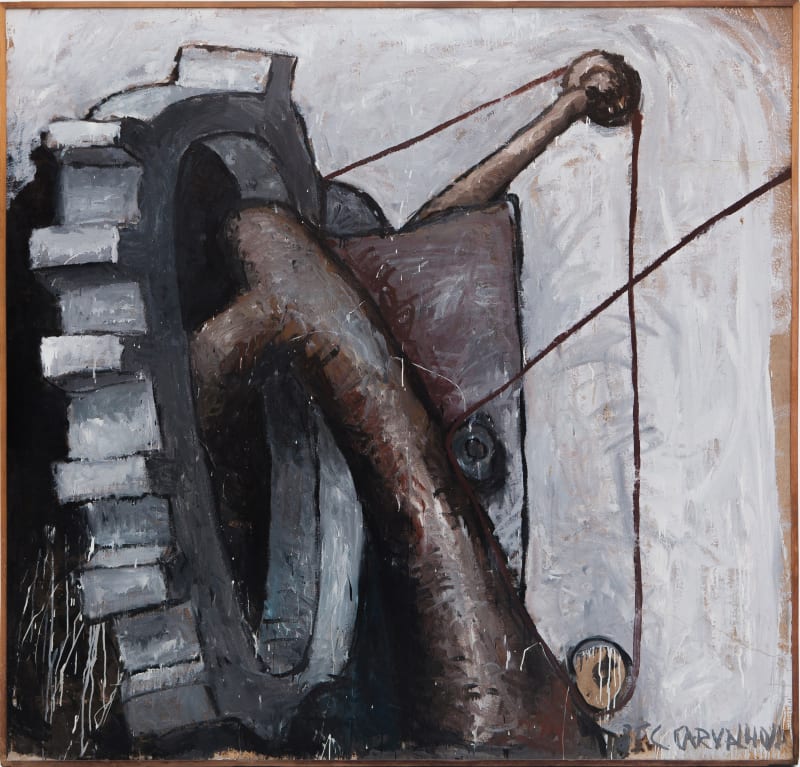Luiz Carlos Cintra Gordinho Carvalhosa (São Paulo, SP, 1961 - idem, 2021). Painter, engraver, sculptor and visual artist. His early production already reveals a constructive concern, seeking links between the expressive dimension of matter and form, exploring the aesthetic properties of materials.
He studies at the School of Architecture and Urbanism at the Universidade de São Paulo (FAU/USP), from 1980 to 1984. Takes a course in metal engraving at the studio of Sérgio Fingermann (1953) between 1980 and 1982, which influences his productions. Also in 1982, he joins the Casa 7 group, with artists Rodrigo Andrade (1962), Fábio Miguez (1962), Nuno Ramos (1960) and Paulo Monteiro (1961).
One of the hallmarks of the Casa 7 group is the creation with low-cost materials, for economic reasons, such as industrial paint and kraft paper. Even with materials unconventional to the visual arts, the group maintains its emphasis on the expressionist-influenced pictorial gesture and collaborates in the reinvention of Brazilian art of its time. An example of Carlito's creation from this phase is the large-scale untitled work (undated), produced with synthetic enamel on paper.
He participated in the 18th Bienal Internacional de São Paulo in 1985, the group's last show, and at the end of the same decade Carlito made paintings with pure wax or mixed with pigments. Later, he began to produce sculptures with diverse and malleable materials, mimetic and with white or translucent colors, such as fabrics, mirrors, and lights. For critic Lorenzo Mammì (1957), the final result reveals the work's construction process, but it also falsifies it, altering data about the materials' properties.
In 1989 Carlito received a grant from the Deutscher Akademischer Austauch Dienst (DAAD) [German Academic Exchange Service] and traveled to Cologne, Germany, where he remained until 1992.
In 1995, he holds a solo exhibition at Centro Cultural Banco do Brasil (CCBB), in Rio de Janeiro, where he presentsCeras Perdidas produced between 1994 and 1995. As noted by the critic Rodrigo Naves (1955), the plasticity of the wax ensures evidence of the constructive process, through the shape of the cylinders that molded them.
In 1996 and 1997, he produces porcelain sculptures, in which he associates the organic aspect with the rigidity and pure appearance of the material. The viewer's perception alternates between the various properties of the pieces, without reaching a harmonic unity. In Naves' opinion, in the artist's creation there is a kind of fissured coexistence between formal aspects, which should be presented unified, generating a certain discomfort, at the same time that it expresses what is interesting in his work.
In 2000, the book Carlito Carvalhosa was published by Cosac & Naify, with texts by Rodrigo Naves, Alberto Tassinari, and Lorenzo Mammì.
His installation Sum of Days occupied the atrium of The Museum of Modern Art (MoMA) in New York in 2011. In it, a structure of translucent material hanging from the ceiling, forming a labyrinth, hides the space around it, allowing the viewer total immersion. Microphones inside the sculpture play the ambient sound recorded the day before.
In the 2014 individual exhibition Precaução de Contato, trunks (old light poles) seem to be suspended by the support of the wall, with the possibility of falling at any moment. The viewer's gaze is lost in his productions, not finding a definitive point of support. This ambiguity is also revealed in the sculptures, whose placement in space always suggests a precarious position, generating discomfort for the gaze. Carlito also exhibits in the group show Passado/futuro/presente: arte contemporânea brasileira no acervo do MAM, at Museu de Arte Moderna de São Paulo (MAM-SP), in São Paulo, in 2019.
Carlito Carvalhosa transfigures object and matter, both in painting and sculpture, undoing the tension of formlessness and providing the viewer with a new look at his final creation.
CARLITO Carvalhosa. In: ENCICLOPÉDIA Itaú Cultural de Arte e Cultura Brasileiras. São Paulo: Itaú Cultural, 2021. Available at: <http://enciclopedia.itaucultural.org.br/pessoa8854/carlito-carvalhosa>. Accessed on: June 16, 2021. Encyclopedia entry. ISBN: 978-85-7979-060-7

